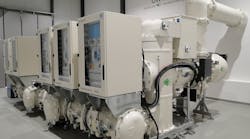In about a year, nine countries have decided to adopt a newly developed technology in the transmission and distribution sector—one that can reduce greenhouse gas (GHG) emissions by up to 99 percent. Green Gas for Grid (g3, pronounced “g” cubed) is an insulating medium for high voltage (HV) switchgear designed by GE Power’s Grid Solutions business, in collaboration with 3M, which has seen growing adoption across the globe as a viable alternative to sulfur hexafluoride (SF6). SF6 is a man-made, fluorinated gas used widely throughout the transmission sector due to its excellent gaseous dielectric properties. However, SF6 also has a global warming potential (GWP) up to 23,500 times greater than carbon dioxide (CO2) and can remain in the atmosphere for 3,200 years. G3 has demonstrated its ability to match the dielectric strength of SF6, with no voltage limitation, and is compatible with the standard materials used in HV equipment, offering the same technical performance, same dimensional footprint, and same ability to operate in ambient conditions as SF6.
The rapid adoption of g3 throughout the global transmission industry is not only a testament to the fervent international commitment to reduce the effects of human activity on climate change, but also demonstrates the enormous potential of collaboration between businesses and governments, when shared goals result in innovative advances in technology that help create a cleaner, smarter world for future generations. Here are three examples of HV substations using g3 instead of SF6.
Danish Dedication to Environmental Responsibility
In Denmark, the country’s largest cooperative energy company, CERIUS, which supplies power to about 400,000 customers, has chosen to use g3 at the Haslev substation in the south of Sjaelland, located approximately 37 miles from Copenhagen, and expects to fully deliver the solution in 2018. CERIUS has committed to promoting greater environmental responsibility by encouraging the development and dissemination of environmentally friendly technologies, as part of the UN Global Compact initiative launched in 2000. The utility will install six full g3-gas-insulated substation (GIS) bays that will be part of the distribution network and supply power to more than 11,000 homes. The project is expected to save about 1,850 tons of CO2 equivalent over a 40-year period, equal to the CO2 emissions from 250 homes for one year, according to the U.S. Environmental Protection Agency’s (EPA) GHG equivalencies calculator.
Swiss Sustainability Efforts See Success
In Switzerland, a group of environmentally minded utilities from across Europe gathered in late 2017 at the Etzel substation near Zurich to witness a world first in the transmission and distribution industry: the successful HV testing of g3 on a 145 kV GIS. The groundbreaking g3-enabled substation was requested by GE’s customers, Swiss utilities, Axpo Power AG and the Elektrizitätswerke des Kantons Zurich (EKZ), to confirm g3 as a viable alternative to SF6. Following the tests, site works will continue to connect the high voltage transformers and connect the substation to the network. The energization of the full site will occur in Spring 2018.
National Grid’s Noteworthy Launch
In the United Kingdom, a British multinational electricity and gas utility company, National Grid, became the world’s first utility to energize a SF6-free 420 kV gas-insulated line (GIL) in their Southeast England Sellindge substation using g3. The milestone moment, which took place in April 2017, marked a significant step forward for the transmission industry in addressing the damaging effects of SF6 on the environment. The gas emissions savings over the life of the project are estimated to reach more than 7,000 tons of CO2 equivalent, or equal to the CO2 emissions of 756 homes for one year, according to the U.S. EPA, and will support the utility’s goals of reducing GHG emissions by 45% by 2020 and 80% by 2050. The 230-meter-long, gas-insulated circuits, which connect the substation to the bushings and overhead lines, will also play a critical role in the ElecLink project, which will increase the UK’s energy security, reliability and capacity by connecting with the French electricity transmission network.
Transforming the Transmission Industry
As the race to limit global warming to an increase of 2oC continues in earnest, the successful achievements of these three countries will pave the way for faster deployment of g3 around the world, providing a powerful example of the environmental benefits that can be realized by replacing SF6. g3 is now commercially available and fully type-tested, available for all HV switchgear products above 52kV, and including gas-insulated lines (GIL) up to 420 kV, gas-insulated substations (GIS) up to 145 kV and air-insulated switchgear (AIS) Current Transformers up to 245 kV.


